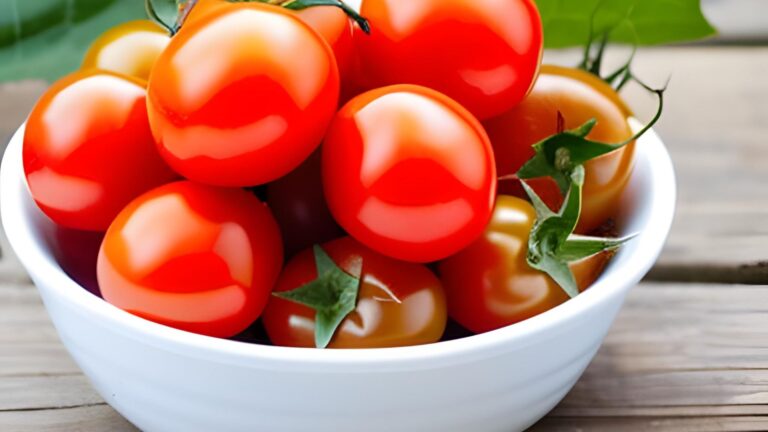In This Article
Key Takeaways
- The optimal time to start tomato seeds indoors in South Carolina is 6-8 weeks before the last expected frost date.
- Direct sowing of tomato seeds in the garden is recommended when the soil temperature reaches 60°F.
- Disease-resistant tomato varieties like ‘Celebrity,’ ‘Better Boy,’ and ‘Mountain Pride’ are recommended for South Carolina’s humid climate.
- Proper seedling care, gradual exposure to outdoor conditions, and watering are crucial for successful tomato plant growth.
When To Plant Tomatoes In South Carolina?
With its warm and humid climate, South Carolina is a tomato lover’s paradise. The state’s long growing season and fertile soil provide the perfect conditions for these juicy and flavorful fruits to thrive.
But when exactly should you plant your tomatoes to ensure a bountiful harvest? In this informative article, we will delve into the depths of South Carolina’s unique climate and explore the best practices for planting tomatoes. From selecting the right tomato varieties that are well-suited for the region to starting seeds indoors or directly sowing in your garden, we will guide you through every step.
Additionally, we will provide valuable tips on caring for your plants and maximizing their growth potential properly. So grab your gardening gloves and embark on a tomato-growing journey that will leave you with mouthwatering rewards!
Understanding the South Carolina Climate
The climatic conditions in South Carolina play a crucial role in determining the optimal time for planting tomatoes.
South Carolina’s tomato planting schedule varies depending on the region and specific weather patterns.
The state experiences a humid subtropical climate characterized by hot summers and mild winters.
The optimal growing conditions for tomatoes include full sun exposure, well-drained soil with adequate moisture, and temperatures between 70-85°F.
Understanding these factors is essential when choosing the right tomato varieties for successful cultivation.
Choosing the Right Tomato Varieties
This discussion will focus on two key points regarding tomato varieties for South Carolina: determinate vs. indeterminate tomatoes and disease-resistant types.
Determinate tomatoes are compact plants that stop growing once they set fruit, making them suitable for smaller gardens or containers.
Indeterminate tomatoes, on the other hand, continue to grow and produce fruit throughout the season, requiring more space and support.
Additionally, choosing disease-resistant varieties is crucial in South Carolina due to the humid climate and high prevalence of diseases such as early blight and late blight.
These varieties have been bred to resist common tomato diseases, ensuring a successful harvest in this region.
Determinate vs. indeterminate tomatoes
Like a sprawling vine, indeterminate tomato plants continue to grow and produce fruit throughout the growing season. Unlike determinate varieties that grow to a predetermined height and produce fruit simultaneously, indeterminate tomatoes require staking or caging for support. This makes them ideal for growing in containers where space is limited.
Now let’s move on to another important aspect of choosing tomato varieties: disease-resistant options for South Carolina.
Disease-resistant varieties for South Carolina
One important consideration when selecting tomato varieties in South Carolina is the availability of disease-resistant options. Given the hot climate, choosing varieties that can withstand common diseases, such as bacterial spots and fusarium wilt, is crucial.
Some recommended disease-resistant varieties for South Carolina include ‘Celebrity,’ ‘Better Boy,’ and ‘Mountain Pride.’ These varieties have been specifically bred to resist diseases prevalent in hot climates.
Transitioning into starting seeds indoors, it is essential to begin the process early to ensure a successful growing season.
Starting Seeds Indoors
Starting tomato seeds indoors requires careful timing to ensure successful transplanting. Starting tomato seeds indoors 6-8 weeks before your area’s last expected frost date is generally recommended. Proper seedling care is crucial, including providing adequate light, moisture, and nutrition.
When it comes to transplanting, it is important to harden off seedlings gradually by exposing them to outdoor conditions before planting them in the garden.
Timing for starting tomato seeds indoors
To ensure optimal growth and yield, what is the most suitable time to initiate the germination process for tomato seeds indoors in South Carolina?
It is important to consider the timing for transplanting seedlings and avoid common mistakes in starting tomato seeds indoors. Here are four key points to keep in mind:
1) Start seeds 6-8 weeks before the last frost date.
2) Use a sterile seed-starting mix.
3) Provide adequate light and warmth for germination.
4) Transplant seedlings outdoors after all danger of frost has passed.
Proper seedling care and transplanting tips will be discussed in the next section.
Proper seedling care and transplanting tips
Proper care and transplanting techniques ensure tomato seedlings’ successful growth and establishment indoors. Seedling nutrition is essential during this stage, providing nutrients for healthy development.
Additionally, the hardening-off process prepares seedlings to transition from indoor to outdoor conditions, gradually acclimatizing them to sunlight and temperature changes. Once seedlings have been properly cared for and hardened off, they can be transplanted into the garden for direct sowing.
Direct Sowing in the Garden
Direct sowing of tomato seeds in the garden is typically recommended when the soil temperature reaches a consistent 60 degrees Fahrenheit. This usually occurs in late spring or early summer in South Carolina.
To ensure successful direct sowing, it is important to:
- Choose a sunny location
- Prepare the soil by removing weeds and loosening it with a tiller or garden fork.
- Plant the seeds at the proper depth according to the package instructions
Additionally, providing adequate water and protection from pests can greatly increase the chances of successful direct sowing of tomato seeds in the garden.
When To Plant Tomato Seeds Directly In The Garden
When considering the optimal time for sowing tomato seeds directly in the garden, it is crucial to consider the specific climatic conditions of South Carolina.
Direct sowing offers several benefits, including better root development and higher chances of survival.
However, common tomato pests such as aphids and hornworms may pose a threat.
Following certain tips and practices discussed in the subsequent section is important to ensure successful direct sowing.
Tips for successful direct sowing
Implementing recommended techniques and practices is essential to maximize the chances of successful direct sowing. Direct sowing offers several benefits, such as better root development and reduced transplant shock. However, common mistakes can hinder success, such as planting seeds too deeply or not providing adequate watering.
Following proper seed spacing, soil preparation, and watering guidelines is important to ensure optimal results. Providing proper care and maintenance after direct sowing is crucial for the continued growth of tomato plants.
Providing Proper Care and Maintenance
Proper care and maintenance of tomato plants in South Carolina are essential for their optimal growth and productivity. Careful watering and protecting the plants from pests are two important aspects. Tomato plants require consistent moisture, but overwatering can lead to disease.
It is recommended to water at the base of the plant early in the morning or late in the evening. Additionally, using organic pest control methods such as companion planting or applying natural repellents can help protect the plants from common pests. You can ensure a healthy tomato harvest by providing proper care and protection.
Harvesting and Enjoying Your Tomatoes
Harvesting ripe, juicy tomatoes from a well-tended garden brings a sense of satisfaction and the promise of delicious meals.
To enhance your tomato harvesting experience, consider the following tips:
- Gently twist or cut tomatoes from the vine to avoid damaging the plant.
- Harvest tomatoes when they are fully ripe for optimum flavour.
- Store harvested tomatoes at room temperature to maintain their taste and texture.
Explore tomato recipes such as Caprese salad, bruschetta, or homemade pasta sauce to make the most of your harvest.
Frequently Asked Questions
How long does it take for tomato seeds to germinate indoors?
Tomato seeds typically take 5-10 days to germinate indoors. To ensure successful germination, provide optimal conditions such as a temperature range of 70-80°F, consistent moisture, and well-draining soil. Regularly monitor the seedlings for growth and adjust light exposure accordingly.
Can I grow tomatoes in containers in South Carolina?
Growing tomatoes in containers in South Carolina has its pros and cons. While containers offer flexibility and control over soil conditions, they require regular watering and may limit plant size. The best varieties for container gardening include ‘Patio’, ‘Tiny Tim,’ and ‘Celebrity.’
What common pests and diseases affect tomato plants in South Carolina?
Common pests and diseases affecting South Carolina tomato plants include aphids, whiteflies, tomato hornworms, early blight, bacterial spots, and fusarium wilt. Proper pest management practices and disease prevention techniques are crucial for successful tomato cultivation in the region.
How often should I water my tomato plants in South Carolina?
The optimal watering frequency for tomato plants in South Carolina depends on soil moisture levels. Maintaining consistent soil moisture and avoiding overwatering and underwatering is important to ensure healthy plant growth and fruit development.
Are there any specific tips for successfully growing tomatoes in the coastal areas of South Carolina?
Tips for coastal gardening in South Carolina include selecting tomato varieties resistant to common coastal pests and diseases, providing ample sunlight and well-drained soil, using mulch to retain moisture, and regularly monitoring plants for signs of stress or nutrient deficiencies.
Conclusion
Tomatoes can be successfully grown in South Carolina by following simple steps. Understanding the climate is crucial, as it determines the planting time.
Choosing the right tomato varieties suitable for South Carolina’s hot and humid weather is important for a successful harvest.
Starting seeds indoors allows for better control over growing conditions.
Direct sowing in the garden should be done when all frost danger has passed.
Proper care and maintenance throughout the growing season ensure healthy plants and abundant fruit.
With these tips, you’ll soon enjoy a bountiful harvest of delicious tomatoes!
Are You New To Tomato Answers?
If you are new to Tomato Answers, here are a few resources to help you:
- Living in Oklahoma and planning your tomato garden? Learn When to Plant Tomatoes in Oklahoma.
- Not sure about the best time to plant in Indiana? Discover When to Plant Tomatoes in Indiana.
- Planning your tomato garden in Iowa? Find out When to Plant Tomatoes in Iowa.
- Looking to grow tomatoes in the beautiful state of Colorado? Learn When to Plant Tomatoes in Colorado.
- Planting tomatoes in the sunny state of Florida? Here’s When to Plant Tomatoes in Florida.
- Planting tomatoes in the vast lands of Alaska? Learn When to Plant Tomatoes in Alaska.

